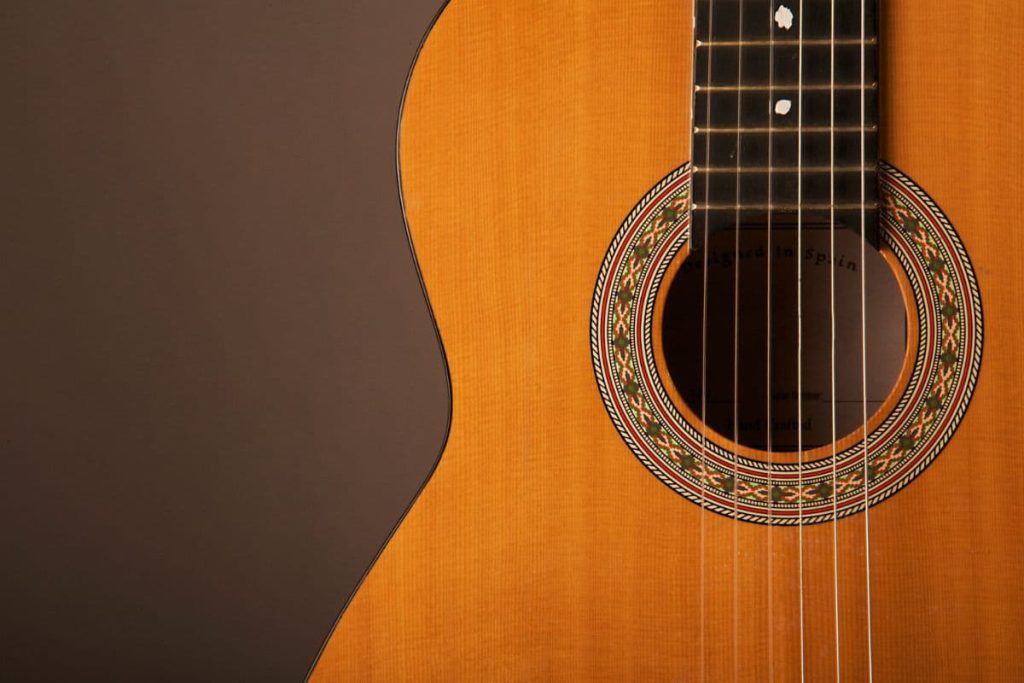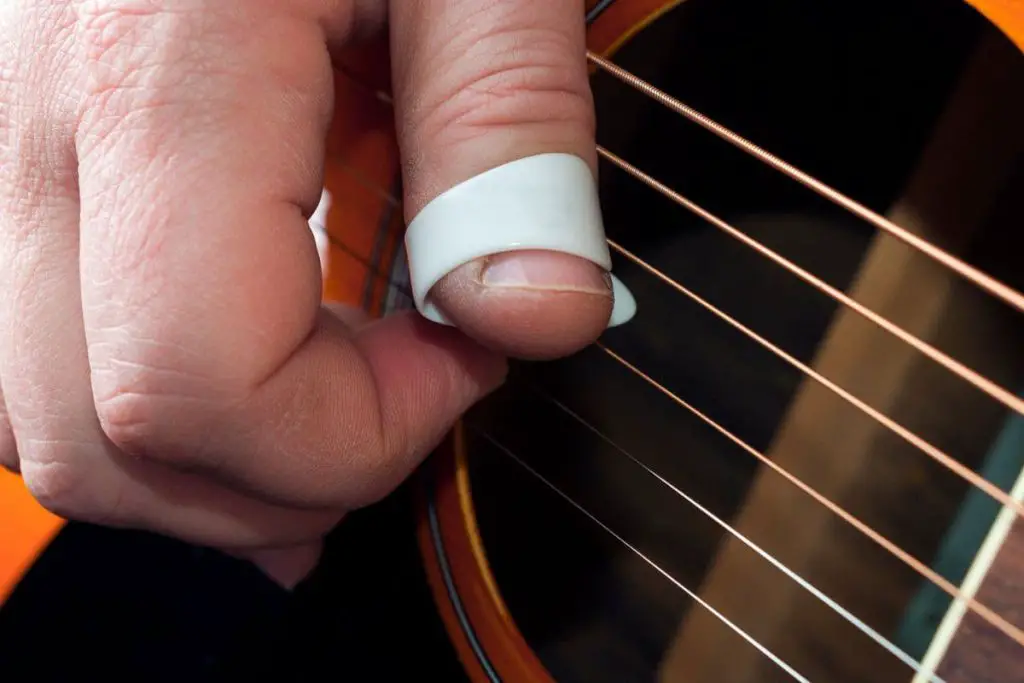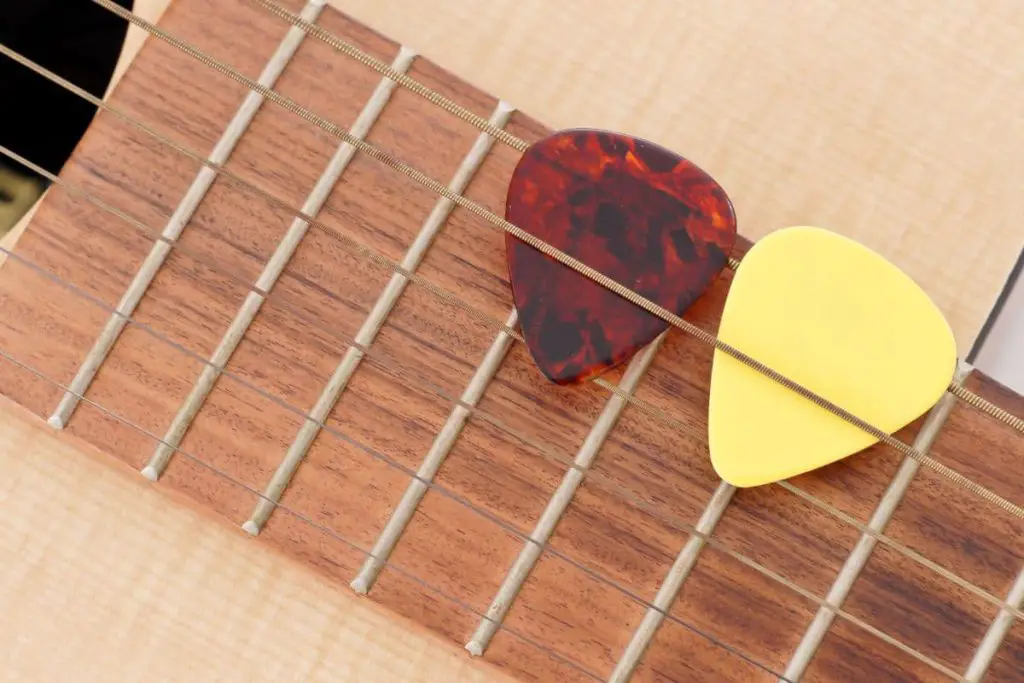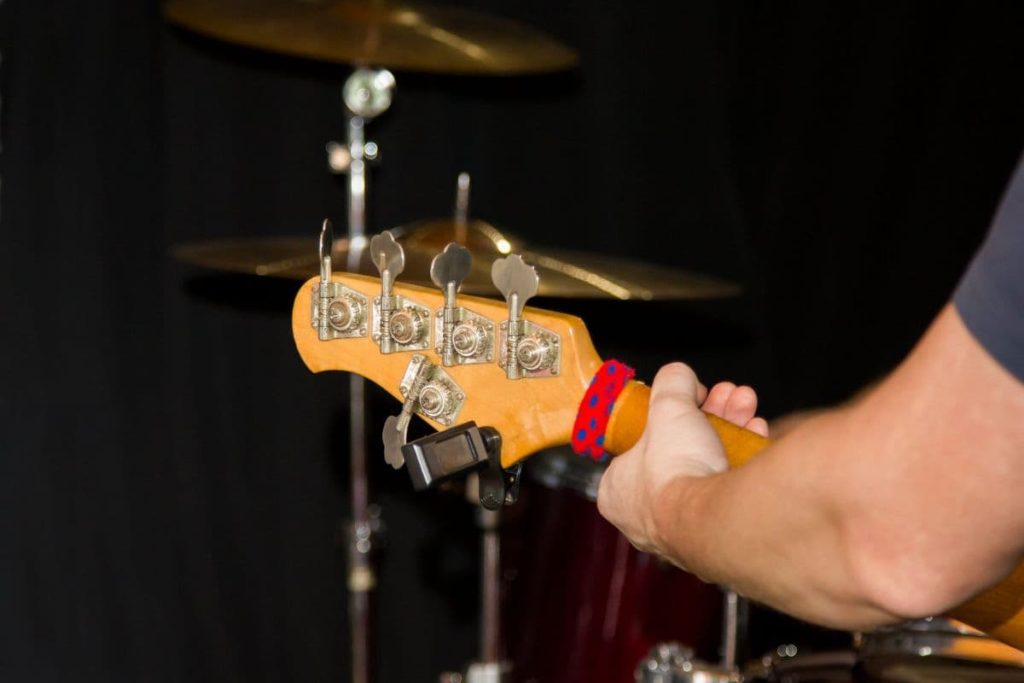Making your acoustic guitar quieter means you can play it at home, at the park, or anywhere you want without disturbing other people. It’s also an excellent idea if you have neighbors who complain about loud sounds or roommates who don’t want to hear you play the guitar late into the night.
To make an acoustic guitar quieter, put a shirt in the soundhole, choose lighter strings, and stick to fingerpicking. You can also get a feedback dampener or an acoustic silencer to quickly reduce your acoustic guitar’s volume. Thinner picks and lighter strings will slightly lower the sound, too.
In this article, we’ll show you how you can make your acoustic guitar quieter with high-quality products and at-home modifications. We’ll also mention playstyles that are better for quiet guitar playing.
👇😀👇NOTE👇😀👇
If you want to find out what my recommended guitar gear is, then here is what I recommend on Amazon:
- Fender Cutaway Acoustic-Electric Guitar Bundle (MY FAVORITE GUITAR)
- Snark SN-8 Super Tight All Instrument Tuner (Easiest Tuner I’ve Used😏)
- 6 String Acoustic Guitar Capo (Best CAPO for quick changes)
- Dunlop Max Grip 1.0mm Nylon Picks (Thick Guitar Pick So You Don’t Lose Grip!)
- Universal Guitar Stand (Cheap & Minimalist Guitar Stand I Recommend)
- Levy’s 2″ Wide Quick Adjust Guitar Strap (Best Guitar Strap For Any Level)

Put a Shirt in the Sound Hole
According to Guitar Gear Finder, stuffing a guitar’s sound hole with a shirt is one of the most well-known ways to reduce the sounds. Large guitar bodies resonate sound much more, so stuffing a shirt into the space will reduce the area for the vibrations to resonate. When there’s less room for the sound to sustain, there’s less overall volume.
Try these suggestions:
- Roll up several shirts and place them in the sound hole for maximum effect. The more shirts you have in the guitar, the better. If you don’t want any sound coming from your guitar, you’ll have to clip the strings to the base of the fretboard. However, this method will reduce a customizable amount of volume.
- Toss a few socks or one shirt into the sound hole to slightly dampen the sound. If you don’t want to completely dampen the noise, you could stick to a few pieces of small clothing or small hand towels. They’ll reduce some of the sound waves, making your guitar sound slightly more muffled than usual.
- Keep the clothes and other soft items near the edges of the guitar rather than right under the strings. Most of the sound bounces off of the outer walls of the guitar’s body. If the walls are covered by clothes, they’ll reduce the vibrations and minimize the sound hole’s volume output.
- Remove the clothes from the guitar if you want to record your instrument through the pickup. While this method is great for playing without a plug-in recording setup, it’ll muffle and distort the sound when it’s plugged into something. For example, it’s not too useful if you have an audio interface.
- Make sure the shirt doesn’t contact the strings from underneath. If the clothes or towels in the sound hole touch the strings, the string won’t make any sounds. If they do make noises, they might buzz or hum. Compress the items under the sound hole, then fluff everything around the edges.
Get Lighter Strings
Lighter strings are much thinner than heavy strings. They’re the best choice for people who have trouble fretting their favorite chords, but they’re also an excellent option for fingerpicking. If you want to produce less noise when playing the acoustic guitar, we suggest looking for a lower gauge for every string.

Here’s a list of reasons lighter strings make your guitar quieter:
- They carry fewer vibrations. As we’ve mentioned above, guitar sounds are primarily based on vibrations. If you reduce the string’s gauge, you’ll lower the vibrations, thus making the guitar quite a bit quieter. It also means the vibrations don’t send as much pressure or tension through the sound hole.
- Lighter strings don’t sustain the sound as long as heavier strings. Thick strings have more surface area to resonate. When the strings resonate longer, they produce louder sounds that stick around for a few more seconds. Choose thin, lightweight strings if you want to reduce the sustained sound output.
- Thinner strings can bend easier, so you won’t have to add too much pressure (which reduces the noise output). Bending the strings while strumming or fingerpicking increases the pitch and alters the vibrations. When the strings are thin, they move much easier and don’t increase the vibrations at all.
- You don’t have to strum as hard when you have light strings on your acoustic guitar. The harder you strum, the more vibrations happen in the guitar. When you can strum lighter due to the lighter strings, you naturally reduce the vibrations. Your guitar will be much quieter.
Install a Feedback Dampener
Feedback dampeners connect to your guitar’s soundhole. Since the vibrations and noise come out of the sound hole, you can instantly quiet the instrument with various dampers. Find the right size for your acoustic guitar, then choose the thickness and density. Thicker, denser materials dampen the sound much more.
The D’Addario Planet Waves Feedback Dampener is designed to fit most acoustic guitars. The thick material prevents too many sounds and vibrations from coming through the soundhole. However, you’ll still be able to hear enough to practice your favorite chords and strumming patterns.
Fingerpick Instead of Strumming
Fingerpicking is often seen as a bit more challenging than strumming. However, it’s much quieter because there’s less pressure and fewer vibrations. You can practice your favorite melodies and combine fingerpicking with hammer-ons, bends, and pull-offs. Some of the best acoustic guitar solos use fingerpicking, so why not give it a shot?
You can mix fingerpicking with thumb strumming if you don’t want to be too loud. Speaking of which, strumming with your fingers is always quieter than using a pick.

Try an Acoustic Silencer
Acoustic silencers are soft pads that gently touch each of the strings. They often sit near the saddle, providing strong sound dampening. The best part about using acoustic silencers is that they won’t slide around, scuff your guitar, or ruin your chords. You’ll be able to hear the strings, but your roommates and neighbors won’t have to.
The Dilwe Guitar Mute Silencer is a universal acoustic silencer that drastically lowers your guitar’s sound output. While you won’t be able to hear as much intonation as the aforementioned feedback dampener, you can still get a solid practice session out of it. Fit it to the base of the strings and strum as hard as you want to.
Mute the Strings With Your Palm
Muting your guitar strings will make them close to silent. However, you’ll still be able to hear minor key changes, which makes this technique a great choice for beginners. If you want to play your guitar at night or in a quiet place, it’s an excellent idea to master the art of palm muting.
Soundproof Panda shows palm muting can be done by putting your strumming hand’s pinky on the strings.
However, you should remember these palm muting tips:
- Never lift the far end of your palm (or your pinky) off of the base of the strings. The constant pressure is what prevents the guitar from making too much noise. The second you pull the edge of your palm off the strings, it’ll be just as loud as it usually is. It’s a bit tricky, so maybe practice it a bit before using it in a quiet space.
- The closer you get to the saddle, the louder you’ll be able to play. Keep your pinky or the edge of your palm right at the saddle, and you’ll still be able to distinguish the chords and individual strings. If you don’t mind reducing the clarity in favor of lowering the noise output, you could bring your palm closer to the sound hole.
- Moving across the sound hole will make it impossible to hear your acoustic guitar. The goal is to have your palm or pinky touching the firm parts of the strings. Since the strings over the sound hole are much more flexible, they remove the sound without producing anything that you can work with.
- Palm muting is a fantastic tool for learning how to fingerpick without being too loud. You only need to use your pinky or the edge of your palm, so you’ll still have four fingers ready to pick. This method helps you create and learn fingerpicking patterns without needing feedback dampeners or acoustic silencers.
- Palm muting shouldn’t be combined with other methods on this post because it’ll remove the sound completely. You’ll quickly notice that palm muting takes away almost all of the noise coming from your acoustic guitar. When used correctly, this unique method can become a regular part of your music and chord progressions.
Use Thinner Picks
Thin picks are often easier to use, a bit cheaper, and more flexible. They’re also more forgiving because they’re not as loud as thick picks. If you want to play a bit quieter, reach for the thinnest pick you can find. While it won’t cut down the noise as much as some of the other suggestions above, it’ll definitely make a difference.

So, why does pick size affect your acoustic guitar’s volume?
- Thin picks produce fewer vibrations, which means they don’t make as much noise. Your pick won’t move the string too much, but it’ll be enough to make plenty of noise. People often choose these picks if they want to play much faster because they’re lighter and easier to move.
- You don’t have to make as much contact with a thin pick, so the pressure is significantly reduced. Less pressure means fewer vibrations, so the saddle doesn’t send as much sound through the sound hole. You can barely touch each string with a thin pick, and you’ll have enough sound to work with.
- Most thin picks don’t blend the sound as much as thick picks because the sound is more distinguished. Thick picks and heavy strings blend the chords, whereas thin picks and light strings are better for individual picking and unique sounds. However, you can still get a decent amount of sound when strumming hard with a thin pick.
Fender Classic Celluloid Guitar Picks come in a 12-pack of thin picks. You can choose other thicknesses if you prefer less flexibility. The ultra-flexible design pairs well with any acoustic guitar, especially those with light strings. Every pack comes with several color combinations, so there’s don’t doubt you’ll end up with the perfect one for your playstyle.
If you go with a thinner pick to make your acoustic guitar quieter, we suggest pairing it with light strings and lower action. These three minor adjustments could be exactly what you need to enjoy your instrument without making too much noise. Let’s talk about lowering the action in the following section.
Lower the Action
Lowering the action will undeniably lower the volume coming out of your guitar. It’s important not to have it too low, or you’ll end up with buzzing strings. While it’s recommended to keep the high E at 2.0mm and the low E at 2.8mm, you can mess around with these dimensions to find the perfect setup for your instrument. However, keep in mind that the guitar shouldn’t bow.
Here’s the easiest way to lower your acoustic guitar’s action:
- Remove the strings (it’s doable with the strings, but it’s much easier to change the action without the strings in the way). Make sure you only remove about two or three strings at a time. Pulling off too many strings runs the risk of putting too much pressure on the saddle, bridge, and nut.
- Use an Allen key to slowly turn the adjustment nut at the top of the sound hole and the base of the fretboard. Check with the manufacturer or measure it with measuring tape to find out what size you need. Make sure you only move it about ¼ of a turn because a small rotation drastically alters the action.
- Check the side of the fretboard to ensure it’s as flat as possible. While not all guitars can get completely flat, most of them can get close to it. You can also use a fretboard measurer to know if the action is where it needs to be. The lowest part of the strings on the highest fret should be slightly higher than the opposite side.
- String the guitar (consider using lighter strings as mentioned above). Light strings will be the better choice if you want to play a bit quieter. Again, stick to stringing two or three strings, undo the other set, then string the new set. Don’t rush the process because you’ll risk snapping a string.
- Tune the guitar and ensure none of the strings buzz. If it buzzes no matter how you tune it, you might need to slightly reduce the action. When the action is too high or low, the strings rest on the frets rather than hovering over them. Pick each string from top to bottom to check for fret buzzes.
Place Something Soft Under the Strings
Tone Topics claims you can put all sorts of padded objects under the strings to reduce an acoustic guitar’s sound output. For example, you can use folded towels, microfiber cloths, shirts, socks, and many other items. Reducing the acoustic guitar’s vibrations will make it significantly quieter every time you strum it.

Keep these details in mind beforehand:
- Place the item as close to the saddle as possible to prevent it from muting the strings. When it’s too far from the saddle, none of the vibrations will reach the bridge. If the bridge doesn’t vibrate, none of the sounds will come out of the sound hole. However, they’ll go through if the item is pressed against the saddle.
- The bigger the cushioned item, the more dampening it’ll do. Switch between one or two socks, handkerchiefs, and other items to find out what works best for your acoustic guitar. You might find that puffy clothes are too much because they dampen almost every noise coming from the sound hole.
- Don’t put anything with buttons or hard strings on your guitar. These attachments can scratch and scuff the guitar, so it’s not worth risking it. Furthermore, the buttons and other items can press against the strings and mute them completely. The best method is to roll the clothing article and stuff it to the base of the saddle.
- Make sure the item is snug under the strings so it can’t slide around. If the item slides around, it might not dampen the volume enough. You’ll notice that some of the strings are muted while others aren’t dampened whatsoever. You should be able to wiggle the acoustic guitar without the item slipping at all.
- It’s best not to put anything under the strings that could remove the bridge pins. If the item is too big, it’ll put upward pressure on the pins. These pins hold each of the guitar strings. If the pins move, they could snap the strings, ruin the intonation, or mute the guitar.
Final Thoughts
There are countless reasons that you could want to make your acoustic guitar quieter. The good news is that you’re now well equipped to strum and fingerpick without making too much noise. Enjoy your favorite instrument without sacrificing clarity and practice wherever you take it.
👇😀👇NOTE👇😀👇
If you want to find out what my recommended guitar gear is, then here is what I recommend on Amazon:
- Fender Cutaway Acoustic-Electric Guitar Bundle (MY FAVORITE GUITAR)
- Snark SN-8 Super Tight All Instrument Tuner (Easiest Tuner I’ve Used😏)
- 6 String Acoustic Guitar Capo (Best CAPO for quick changes)
- Dunlop Max Grip 1.0mm Nylon Picks (Thick Guitar Pick So You Don’t Lose Grip!)
- Universal Guitar Stand (Cheap & Minimalist Guitar Stand I Recommend)
- Levy’s 2″ Wide Quick Adjust Guitar Strap (Best Guitar Strap For Any Level)
Related Posts:

